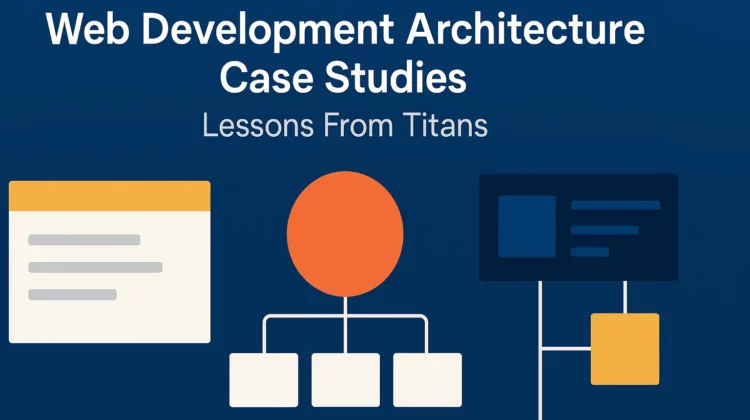
Have you ever scratched your head wondering how the biggest names in tech keep their web apps humming with millions—or heck, billions—of users hammering them daily? Here we are going to dive deep with some downright epic web development architecture case studies. We’re talking Facebook, X (Twitter), Amazon, Google, Uber, and Airbnb—giants who’ve cracked the code on scalability and performance. Buckle up because I’m diving in with a casual vibe, a sprinkle of first-person flair, and a ton of insights for you, whether you’re just starting or you’ve been slinging code for years.
Why Web Development Architecture Rules the Game
Let’s kick things off with the basics. Web application architecture? It’s the rock-solid foundation of your app. The skeleton that holds everything together—your UI, database, servers, all that jazz. Nail it, and your app scales like a champ, stays lightning-fast and doesn’t crumble when the traffic spikes hit. Mess it up, and you’re stuck patching leaks while users bounce.
For me, it’s like building a skyscraper. A killer architecture handles growth without toppling over. Scalability, performance, and reliability—these are the holy trinity every engineer chases. And trust me, the case studies we’re about to unpack show exactly how the pros pull it off.
Web Development Case Studies: The Heavy Hitters
Alright, let’s get to the good stuff. I’ve rounded up six mind-blowing web application architecture case studies from the tech titans. Each one’s a masterclass in solving real-world problems with killer tech stacks and brainy solutions. Here’s the rundown.
Facebook: The Great Tech Stack Rebuild
Facebook’s web app started as a scrappy PHP site back in 2004. By 2020, it was a bloated beast—slow, clunky, and a nightmare to update. So, they tore it down and rebuilt it from scratch—a total tech stack overhaul! They leaned into modern JavaScript frameworks, optimized for today’s browsers, and made it feel like a native app.
The result? Pages load faster, new features roll out in weeks instead of months, and the whole vibe is slicker than ever.
The lesson here: if your tech stack’s dragging you down, don’t patch it—rebuild it. It’s brutal, but it works.
Source: Tech Stack Rebuild At Meta
X (Twitter): Twitter Lite PWA Magic
X wanted their mobile web to scream speed without forcing users to download an app. Their old mobile site was a slug on slow networks. Enter Twitter Lite, a lean, mean, and offline-ready Progressive Web App (PWA). To juice up performance, they tapped service workers for caching and lazy loading.
Boom 💥 —”Time To Interactive” (TTI) dropped by half. Users in spotty-signal zones love it.
Takeaway: PWAs are your secret weapon for mobile domination. Fast, app-like, and no app store required.
Source: Largeapps – Twitter Lite Case Study (Brace yourself for a bit longer read)
Amazon: Scaling to Infinity with AWS
Amazon’s the king of online shopping, but Black Friday traffic spikes were a beast. Their old backup system crawled, taking 15 hours to restore data. They flipped the script with AWS—S3 for storage, EC2 for power, and the works. Now, restores take 2.5 hours, and scaling is a breeze.
It’s cloud services done right. They handle insane loads without blinking.
Pro tip: lean on the cloud to stay agile. It’s not just for hip startups—Amazon proves it.
Source: AWS – Amazon Case Study
Google: The Scalability Godfather
Google’s apps—like Search and Gmail—juggle billions of requests daily. Their trick? A distributed system with thousands of cheap servers powered by beasts like MapReduce. They crank out 100,000+ jobs a day, processing data at warp speed.
This setup scales horizontally and pumps out features fast. It’s the gold standard. Build big, think distributed—that’s the Google way.
Source: High Scalability – Google Architecture
Uber: m.uber’s PWA Powerhouse
Uber’s mobile web was a snooze—slow and awkward. They unleashed m.uber, a PWA with service workers caching assets and polling ride updates in the background. It’s snappy, even on flaky connections, and feels native.
Users rave about the speed. Key lesson: performance is king. Cache smart, sync quietly and watch your app shine.
Source: Uber Blog – Building m.uber
Airbnb: Cloud Scaling Done Smooth
Airbnb’s early days were rough—scaling was a mess. They jumped to AWS, tapping EC2, Elastic Load Balancing, and S3. Auto-scaling kicked in as users soared, and now they handle global bookings like it’s nothing.
Cloud’s the hero here. Use it, and focus on features—not server babysitting.
This AWS/AirBnB joint-venture web development case study is a must read. Don’t miss it.
Source: AWS – Airbnb Case Study
The Big Challenges (And How to Crush Them)
These case studies scream patterns. Here’s what keeps popping up—and how the pros smash it:
- Scalability Nightmares: Traffic spikes will murder a weak setup. Cloud services (Amazon, Airbnb), distributed systems (Google), and PWAs (X, Uber) are your armor.
- Performance Hiccups: Lag kills user love. PWAs, caching, and fresh tech stacks (Facebook) keep things zippy.
- Tech Debt Traps: Old stacks slow you down. Rebuild (Facebook) or scale smart (Google) to stay nimble.
Building a web app? Plan for these from day one. You’ll thank me later.
Architecture Showdown: Who Wins What?
Let’s stack all of them in an easy-to-digest manner:
| Company | Tech Stack | Scalability Play | Performance Edge |
|---|---|---|---|
| Modern JS | Full rebuild | Lightning loads, app vibes | |
| X (Twitter) | PWA, React | Caching via service workers | Native speed on the web |
| Amazon | AWS (S3, EC2) | Cloud scaling | Rapid restores, uptime king |
| Distributed systems | MapReduce, server army | Scales forever, data beast | |
| Uber | PWA, service workers | Native speed on the web | Native speed on web |
| Airbnb | AWS (EC2, S3, EMR) | Auto-scaling cloud | Global reach, no sweat |
Cloud and PWAs dominate. Steal those moves for your next gig.
Key Learnings & Takeaways
- Design for elastic scalability. Traffic spikes will instantly expose a weak setup. Tech titans solved “Scalability Nightmares” by leaning on cloud auto‑scaling (e.g., Airbnb on AWS), geo‑distributed services (Google), and battle‑tested deployment pipelines. Build for horizontal scale from day one and stress‑test regularly.
- Performance is a feature, not an after‑thought. “Lag kills user love.” Titans kept pages sub‑second with aggressive caching layers and modern stacks—think Facebook’s React + HHVM and Twitter Lite’s resource‑trimmed PWA. Remember: every 100 ms delay hurts engagement.
- Refactor or die—tame technical debt early. Legacy code slows release velocity. Facebook’s ground‑up rebuild and Google’s targeted refactoring show that investing in rebuilds or smart modular scaling beats perpetual patchwork.
- Serverless is your burst‑load safety net. “Ditch server management, scale effortlessly, pay only for what you use.” Serverless functions shine for spiky workloads and MVPs where time‑to‑market trumps fine‑grained infrastructure control.
- Progressive enhancement wins mobile markets. Twitter Lite proved that lightweight PWAs with service‑workers can deliver 30‑70 % faster load times on slow networks, unlocking huge engagement in bandwidth‑constrained regions.
- Push content closer to users with edge delivery. Cloudflare‑style global CDNs shrink round trips and slash TTFB below 100 ms worldwide—an essential move once traffic turns international.
- Make observability non‑negotiable. Every success story highlighted comprehensive tracing, metrics, and continuous performance tests. Catch regressions before users do.
- Small, autonomous services accelerate velocity. Netflix’s micro‑service army illustrates how independent deployments, fault isolation, and team ownership unleash faster iteration without jeopardizing reliability.
Hot Trends to Steal for Your Next Project
Tech’s a runaway train—stay ahead or get left behind. Here’s what’s cooking:
- Serverless: Ditch server management. Scale effortlessly, pay for what you use. It’s the future.
- Microservices: Chop your app into bite-sized pieces. Flexible and scalable, but don’t sleep on the complexity.
- Edge Computing: Crunch data near users. Faster responses, global domination—it’s a no-brainer.
Netflix rocks microservices, and Cloudflare is all over the edge. Jump on these trains—they’re accelerating fast.
How to Pick Your Perfect Architecture
Staring at a blank slate? Here’s your cheat sheet:
- Traffic Goals: Tiny app or next Facebook? Plan accordingly—cloud for spikes, distributed for insanity.
- Budget Vibes: Cash-strapped? Serverless or PWAs. Deep pockets? Go full microservices.
- Team Skills: Newbies need simple; pros can wrestle complex beasts.
Match your architecture to your reality. It’s not one-size-fits-all.
Wrap-Up: Build Like a Titan
These web development architecture case studies are gold. Facebook’s rebuild guts, X and Uber’s PWA swagger, Amazon and Airbnb’s cloud mastery, Google’s distributed genius—it’s all here. The takeaway? Architecture isn’t optional—it’s your app’s superpower.
Grab these lessons, slap them on your projects, and build something unstoppable.
Web Development Case Studies FAQs
More users, more chaos. Scalability stops the crash and keeps the party going.
Progressive Web App—web with native swagger. Fast, offline-capable, and installable. Mobile gold.
Instant server power on tap. Traffic spikes? No problem—scale up, stay up.
Monolithic’s one big blob; microservices are tiny, independent chunks. Mono’s simpler, micro’s flexure.
A detailed example examining how a particular web application was built or improved, highlighting challenges faced and solutions implemented.
ven small teams can apply the principles: e.g., use CDNs for faster content delivery (like Cloudflare’s edge), adopt modular design early, and prioritize performance optimization.
Discover more from CodeSamplez.com
Subscribe to get the latest posts sent to your email.







[…] you haven’t come across already, I would highly recommend for you to go over the twitter(x)’s case-study to understand the benefits in real-world […]